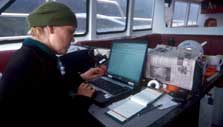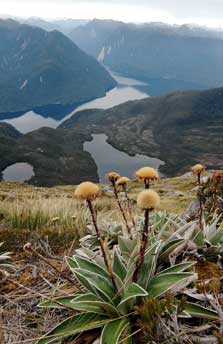
Updating coastal stoat capture database
The Fiordland Islands Restoration Programme has formed science partnerships with several organisations and individuals in order to establish robust monitoring programmes, develop new techniques, and inform progress with pest eradication.
Examples of this work include:
Stoat immigration study – Department of Conservation, Research and Development. A four-year study initiated in 2000 where 19 islands at varying distances offshore in Fiordland were trapped for stoats. Key Findings: The rate of immigration to islands greater than 500 m offshore where mainland trapping is in place land is low even in stoat-plague years (i.e. one stoat every four years).

Alpine view, Secretary Island
Inbreeding in translocated populations of endangered birds (takahe, saddlebacks, NZ robins) and genetic variation in threatened populations of takahe, saddlebacks and robins. Dr Ian Jamieson, University of Otago
DNA sampling of stoats on Secretary Island, and Stoat detection probabilities on Resolution Island - Manaaki Whenua - Landcare Research. Dianne Gleeson, Richard Clayton, Dean Anderson. Andrea Byrom, and Bruce Warburton.
Stoat trap tunnel location: GIS predictive modelling to identify the best tunnel location. Mark Day (MSc student), School of People Environment and Planning, Massey University.
DNA sampling and population modelling of red deer on Secretary Island. Manaaki Whenua - Landcare Research. Graham Nugent, Bruce Warburton.
Long-term vegetation monitoring of forest changes on Secretary Island. Department of Conservation and Manaaki Whenua - Landcare Research.